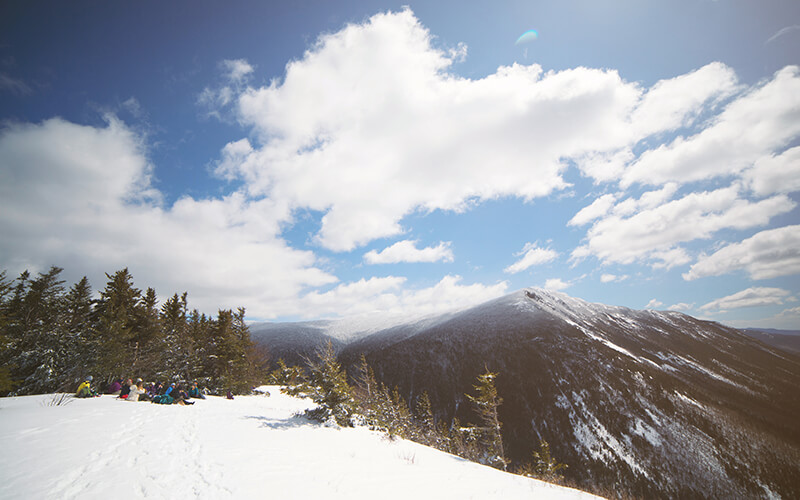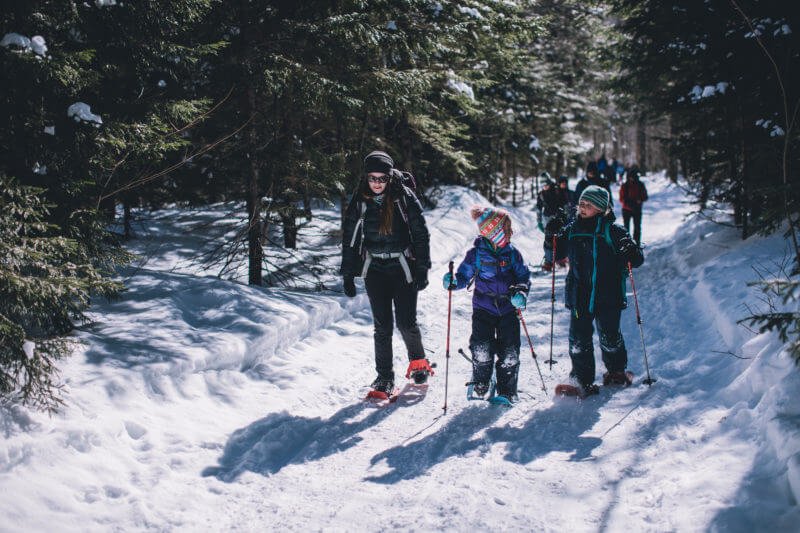

An AMC Women’s Adventure group takes a break on top of Mount Willard during an outdoor skills workshop. Practicing Leave No Trace in winter involves additional factors beyond hiking in other seasons.
Leave No Trace is a practice that applies to any outdoor activity, providing hikers, bikers, skiers, and other users with the tools they need to ensure minimal impact on the environment during their trip. While this seven-principle strategy, developed by Boulder, Colo.-based Leave No Trace Center for Outdoor Ethics, applies to all seasons, winter presents additional factors to consider. Follow our guide for how to Leave No Trace in winter to minimize your impact on the environment and others when heading outdoors this season.
Plan ahead and prepare
This checklist of questions will help you plan out your trip in any season, but winter adds a few considerations when planning an outdoor activity, says Alex Delucia, Leave No Trace programs manager for AMC. First, check the weather forecast and pack extra layers to accommodate potential rain or snow, plus lower temperatures. You’ll also need to factor in slower travel times, shorter days, heavier gear, and reduced capacity for emergency response. If you are heading into avalanche territory, you’ll also need to pack the necessary gear items and to know the signs of potential avalanches before heading out.
Travel and camp on durable surfaces
The same basic rules for camping and hiking in warmer months also apply in winter: Set up camp at least 200 feet from the trail, and when hiking or skiing, stick to the marked trails to help prevent damage to the vegetation below. (This is especially helpful when hiking in deeper snow, as the trail creates a snowpack you can easily travel on versus post-holing into weaker snow. This also provides an easy path for other hikers to follow.) “Snow does make campsite selection much easier,” Delucia says, “but in some areas the lack of leaf cover requires visitors to travel more than 200 feet off trail to prevent being seen.”
Dispose of waste properly
The preferred method in winter is to pack in and pack out all solid waste, including human waste, Delucia says. “You don’t want to fill up composting toilets, as the waste will not breakdown in the winter months, leaving lots of composting for our caretakers each spring. But, if you don’t pack it out, we would rather folks deposit in the composting toilets as opposed to leaving it in the snow to melt out and be on the surface come spring,” he says. While urine may not harm vegetation or soil, it’s important to remember to urinate in a discrete spot at least 200 feet off trail and away from any water sources.


Snowshoers enjoy a trail in New Hampshire’s White Mountain National Forest on an AMC Family Adventure trip.
Leave what you find
A central theme of Leave No Trace is leaving the landscape in the condition as you found it—or better. In winter, this means avoiding going off trail, and leaving any items—natural or cultural—where you found them. Do not build snow structures or cairns, as that can mislead others off the trail (and in winter, could be even more life threatening), and avoid damaging any vegetation.
Minimize campfire impacts
Campfires can leave behind soot and ash, even if set up properly, and can have lasting effects on the environment. In winter, the visual impact can last all season, Delucia says, so it is important to consider ways to minimize your use of campfires in the winter. Snow cover also makes it difficult to find the small twigs and branches you would use as fuel for your fire. “While the campfire might be warm temporarily, you are better off with a stove in the winter,” Delucia says.
Respect wildlife
While keeping your distance from wildlife outdoors is important year-round, it’s especially important in the winter. “Many animals work very hard all summer and fall to store up the necessary energy to get them through the lean winter months. By getting too close and spooking animals, they are unnecessarily wasting energy, which limits their ability to successfully make it through until spring,” Delucia says.
Be considerate of other visitors
Remember that you aren’t the only person enjoying the outdoors, so try to minimize your impact on the experience of others outside. Keep a low profile by wearing neutral-toned outerwear (except in avalanche country, when you should actually wear bright colors that are easy to spot, in case of an accident), avoid making loud noises, wear headphones if you prefer listening to music on the trail, and stick to trail etiquette, as outlined in this article.